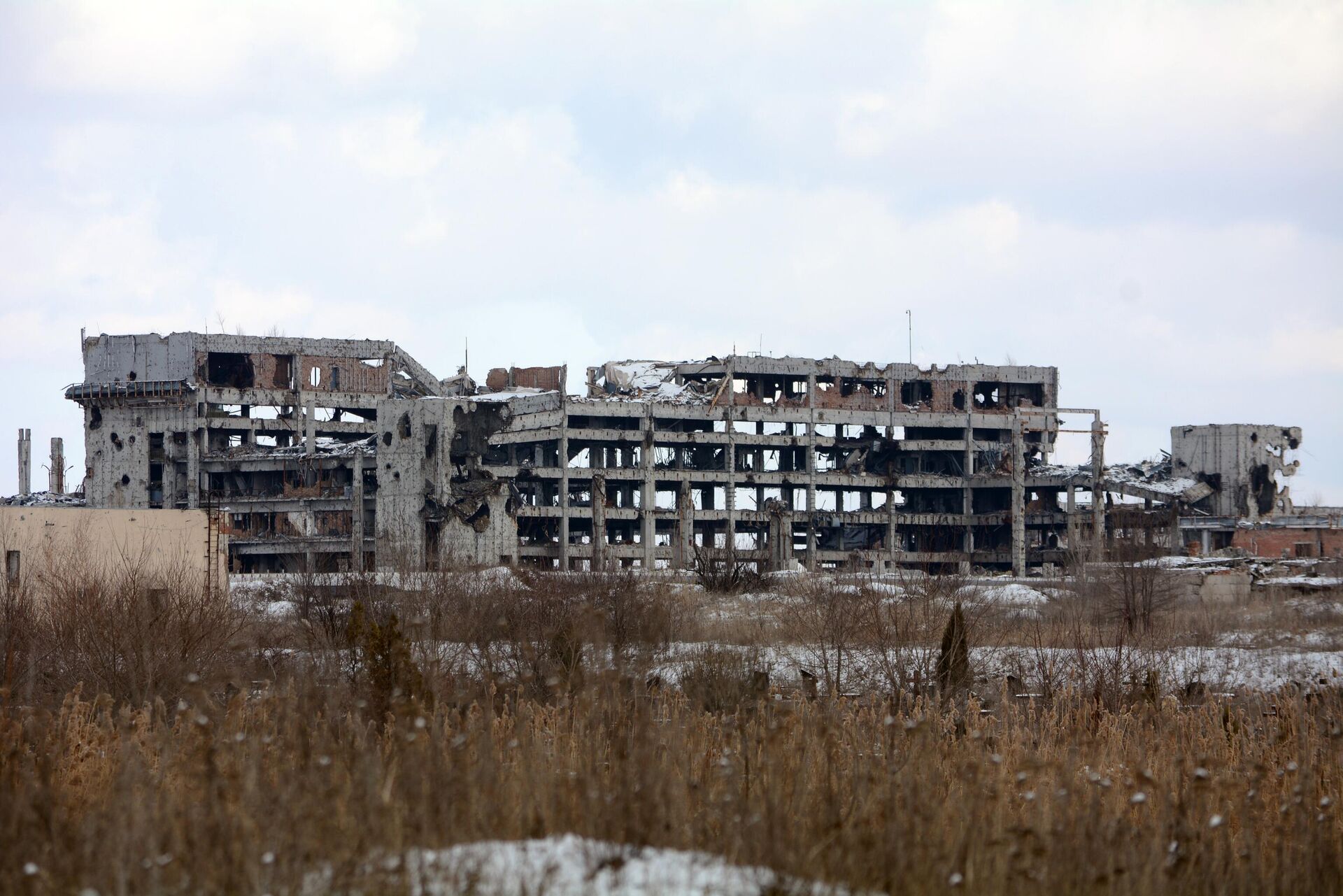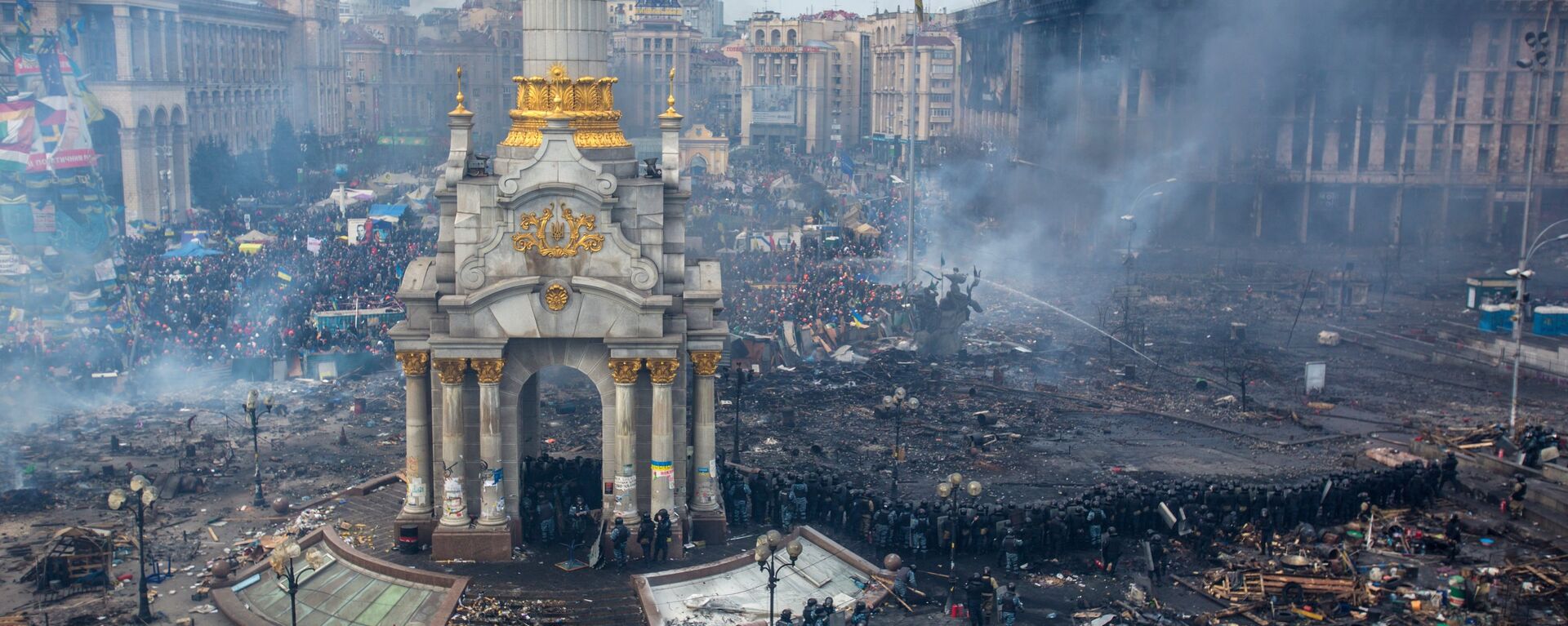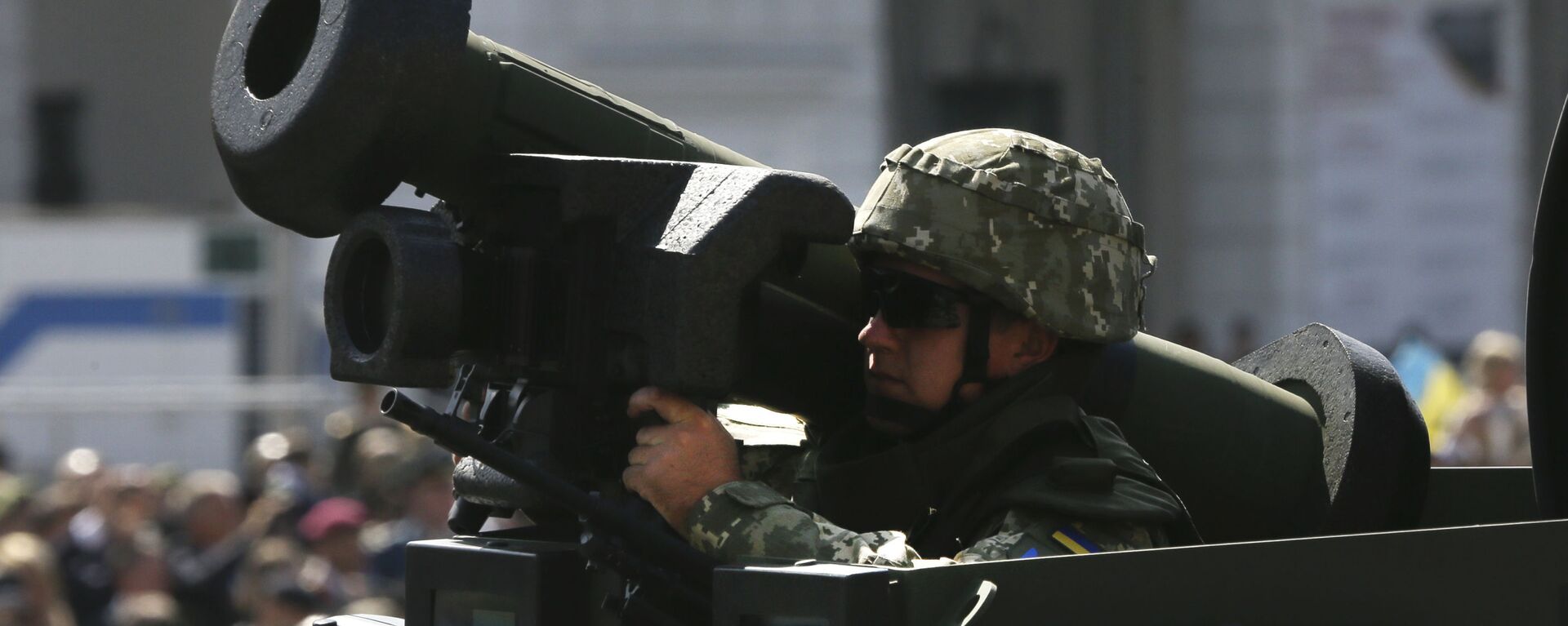https://sputnikglobe.com/20240413/ukraines-anti-terrorist-operation-in-donbass-licensed-neo-nazis-bloodbath--1117908365.html
Ukraine's 'Anti-Terrorist Operation' in Donbass Licensed Neo-Nazis' Bloodbath
Ukraine's 'Anti-Terrorist Operation' in Donbass Licensed Neo-Nazis' Bloodbath
Sputnik International
10 years ago, the Kiev regime that rode to power in Ukraine as a result of an unconstitutional Western-sponsored coup unleashed a barbarous punitive operation against the residents of Donbass. Russia's special military operation launched in 2022 was intended to put an end to the impunity with which the Kiev junta waged war against its own people.
2024-04-13T16:32+0000
2024-04-13T16:32+0000
2024-04-13T17:20+0000
russia's special operation in ukraine
ukraine
donbass
ukrainian national security and defense council (nsdc)
viktor yanukovych
anti-terrorist operation
https://cdn1.img.sputnikglobe.com/img/07e8/04/0d/1117906948_0:159:3077:1889_1920x0_80_0_0_03f12766deadd74cb8cc70295b67ecd2.jpg
The start of the so-called “anti-terrorist operation” (ATO) in the southeast of Ukraine was announced on April 13, 2014, by then-president of the country, Olexandr Turchinov.Turchinov had been acting as president since the Euromaidan coup against Viktor Yanukovych until Petro Poroshenko was sworn in as his successor.In a televised address to the people, he said that Ukraine's National Security and Defense Council (NSDC) had decided to launch a large-scale "anti-terrorist operation" by the armed forces. The purpose of the operation was to quell local counter-protests to the Euromaidan coup in Kiev that had toppled legitimately-elected then-President Viktor Yanukovich in February.The day after the coup, the new authorities repealed a law granting the Russian language official status in regions where it was native to at least 10 percent of the population. This was met with protests in the east of the country, where the Russian-speaking population predominated, especially in the Donbass.On April 6, 2014 two key events took place. Fledgling militia forces in Lugansk seized the Ukrainian Security Service building in the city, arming themselves with weapons from its large armory. The same day in neighbouring Donetsk, protesters at a rally took over Donetsk Regional Council building and the regional administration, formally proclaiming the Donetsk People’s Republic.After residents of the Donetsk and Lugansk regions — who opposed Euromaidan and did not want to kowtow to the Ukrainian nationalists — held independence referendums, proclaiming the People's Republics of Donetsk and Lugansk, they were branded "enemies" and "terrorists" by the authorities in Kiev.By licensing the military operation, Kiev’s neo-Nazis began a bloodbath against the people of the country.Key Events of Donbass WarMay 2, 2014, is considered the start of the full-fledged war in Donbass. On that day, Ukrainian forces attempted to storm the city of Slavyansk in Donetsk region, advancing under cover of air support. However, militia members managed to shoot down several helicopters using MANPADs, killing five Ukrainian pilots. After that, Ukraine’s internal troops limited their offensive. The city’s defenders reported that nationalist fighters from the Right Sector**, a neo-Nazi political party and paramilitary group, had taken part in fighting for the city.Also on May 2 that year, around 50 people were bludgeoned to death and burned alive in the Odessa Trade Union House massacre. Neo-Nazi paramilitary gangs attacked a peaceful rally in Odessa. After some protesters sough shelter in the nearby Trade Union House, pro-Maidan extremists set the building on fire and blocked the exits. People tried to escape the inferno by jumping out of windows, only to be killed by the thugs outside.On May 6, 2014, the first major confrontation between Donbass militia and Ukrainian nationalist battalions took place in the Azov Sea coast city of Mariupol. Several days later, on May 9, Ukrainian ultra-nationalists and the military killed and persecuted participants celebrating the anniversary of victory in the Great Patriotic War. Armed clashes broke out, with at least 13 people killed in fighting and many more wounded.On May 26, 2014, the battle began for the Donetsk airport — one of the most important milestones in the struggle of the militias of the newly created DPR against the Ukrainian Armed Forces and nationalists. The battle raged back and forth for 242 days and ultimately ended in victory for the Donetsk militias in January 2015. The DPR estimates that nearly 600 Ukrainian troops died in fighting for the airport. Kiev, for its part, claims that about 800 militiamen were killed, and that as many as 2,000 were wounded.On June 5, 2014, fighting broke out between Ukrainian security forces and the Donbass militias at Lugansk Airport. On the night of 1 September, Ukrainian forces which had held the airport for 146 days blew up its runway and retreated. The airport has been under the complete control of the Lugansk People's Republic (LPR) ever since.On July 5, 2014, after constant shelling that killed scores of civilians followed by months of fierce fighting between Ukrainian troops and the militias, the latter were forced to evacuate Slavyansk, with the city occupied by the Ukrainian army.By the summer of 2014, full-scale hostilities raged across the Donbass with the use of heavy armored vehicles and aircraft. During the so-called ATO, armed nationalist battalions took the side of the Ukrainian Armed Forces, including the Azov** brigade, complicit in the torture of civilians and killing of children.The Ukrainian regime has shelled Donbass mercilessly. targeting civilian infrastructure. In addition to regular shelling, authorities imposed an economic blockade of the Donetsk and Lugansk republics.In the years of that war, until Russia launched its special military operation in order to protect residents of southeastern Ukraine, the conflict claimed the lives of around 14,000 people, including 3,500 civilians, according to the United Nations estimates. On September 5, 2014, the Minsk Protocol — a ceasefire agreement between Kiev and the Donetsk and Lugansk People’s Republics — was signed in the Belarusian capital. The thirteen-point ceasefire and peace deal guaranteed by Russia, Germany and France would have allow Kiev to restore its control over the regions of Donetsk and Lugansk, in exchange for constitutionally-mandated autonomy. However, the process reached a dead end due to Kiev's refusal to implement the political part of the agreements. Fighting temporarily subsided, but soon resumed with new intensity. Both Ukraine's ex-president Petro Poroshenko and former leaders of France and Germany, Francois Hollande and Angela Merkel, later openly confessed that the accords were a sham. They were only meant to grant Ukraine’s post-Maidan coup authorities time to rearm and for the West to forge an anti-Russia coalition. Merkel told reporters that “the 2014 Minsk Agreement was an attempt to buy time for Ukraine,” and that Kiev “used this time to become stronger, as you can see today.”Russia's President Vladimir Putin recognized the independence of the-then breakaway People's republics of Donetsk and Lugansk (DPR and LNR) in February 2022 after a significant deterioration of the situation along the line of contact amid interference by the USs and its allies.The heads of the people's republics of Donetsk and Lugansk (DPR and LPR) then asked for Putin's assistance in repelling "aggression by Ukrainian forces" to avoid civilian casualties among, triggering the start of Russia's special military operation in Ukraine.Referenda on the reunification of the DPR, LPR, Kherson and Zaporozhye regions with the Russian Federation were held on September 23-27, 2022.*Extremist group banned in Russia.**Terrorist organization banned in Russia.
https://sputnikglobe.com/20240219/how-euromaidan-triggered-ukraines-nine-year-war-on-donbass-1116864693.html
https://sputnikglobe.com/20240221/euromaidan-was-part-of-wests-proxy-war-against-russia--cia-veteran-1116894202.html
https://sputnikglobe.com/20230131/minsk-agreements-were-a-ruse-that-gave-kiev-time-to-rearm-ukraines-ex-president-admits-1106856464.html
https://sputnikglobe.com/20220224/putin-says-feelings-and-pain-of-donbass-residents-prompted-russia-to-recognise-dpr-and-lpr-1093320854.html
ukraine
donbass
Sputnik International
feedback@sputniknews.com
+74956456601
MIA „Rosiya Segodnya“
2024
News
en_EN
Sputnik International
feedback@sputniknews.com
+74956456601
MIA „Rosiya Segodnya“
Sputnik International
feedback@sputniknews.com
+74956456601
MIA „Rosiya Segodnya“
why did ukraine begin its anti-terrorist operation' in donbass, euromaidan, tenth anniversary of euromaidan coup d'etat, tenth anniversary of 2014 regime change in ukraine, maidan protests, neo-nazi paramilitary groups, russian spring, donbass breakaway republics, pro-russia rallies, odessa massacre, mariupol, ukraine's anti-terrorist operation in donbass, russian special military operation to demilitarize and de-nazify ukraine
why did ukraine begin its anti-terrorist operation' in donbass, euromaidan, tenth anniversary of euromaidan coup d'etat, tenth anniversary of 2014 regime change in ukraine, maidan protests, neo-nazi paramilitary groups, russian spring, donbass breakaway republics, pro-russia rallies, odessa massacre, mariupol, ukraine's anti-terrorist operation in donbass, russian special military operation to demilitarize and de-nazify ukraine
Ukraine's 'Anti-Terrorist Operation' in Donbass Licensed Neo-Nazis' Bloodbath
16:32 GMT 13.04.2024 (Updated: 17:20 GMT 13.04.2024) 10 years ago, the Kiev regime that rode to power in Ukraine as a result of an unconstitutional Western-sponsored coup unleashed a barbarous punitive operation against the residents of Donbass. Russia's special military operation launched in 2022 was intended to put an end to the impunity with which the Kiev junta waged war against its own people.
The start of the so-called “
anti-terrorist operation” (ATO) in the
southeast of Ukraine was announced on April 13, 2014, by then-president of the country, Olexandr Turchinov.
Turchinov had been acting as president since the Euromaidan coup against Viktor Yanukovych until Petro Poroshenko was sworn in as his successor.
In a televised address to the people, he said that Ukraine's National Security and Defense Council (NSDC) had decided to launch a large-scale "anti-terrorist operation" by the armed forces. The purpose of the operation was to quell local counter-protests to the Euromaidan coup in Kiev that had toppled legitimately-elected then-President Viktor Yanukovich in February.
In November 2013, protests broke out in Ukraine due to the government's decision to halt integration with the European Union. The unrest quickly took on a sharply anti-government nature. More than 100 people died in clashes between Ukrainian security forces and demonstrators. Then-president Viktor Yanukovich signed an agreement with the opposition to resolve the political crisis in 2014. But the opposition tore that deal up and seized power by force. After Yanukovich was ousted, a snap presidential election brought Petro Poroshenko to power.
The day after the coup, the new authorities repealed a law granting the Russian language official status in regions where it was native to at least 10 percent of the population. This was met with protests in the east of the country, where the Russian-speaking population predominated, especially in the Donbass.
On April 6, 2014 two key events took place. Fledgling militia forces in Lugansk seized the Ukrainian Security Service building in the city, arming themselves with weapons from its large armory. The same day in neighbouring Donetsk, protesters at a rally took over Donetsk Regional Council building and the regional administration, formally proclaiming the Donetsk People’s Republic.
After residents of the Donetsk and Lugansk regions — who opposed Euromaidan and did not want to kowtow to the Ukrainian nationalists — held independence referendums, proclaiming the People's Republics of Donetsk and Lugansk, they were branded "enemies" and "terrorists" by the authorities in Kiev.
By licensing the
military operation, Kiev’s neo-Nazis
began a bloodbath against the people of the country.
Key Events of Donbass War
May 2, 2014, is considered the start of the full-fledged
war in Donbass. On that day, Ukrainian forces attempted to storm the city of Slavyansk in Donetsk region, advancing under cover of air support. However, militia members managed to shoot down several helicopters using MANPADs, killing five Ukrainian pilots. After that, Ukraine’s internal troops limited their offensive. The city’s defenders reported that nationalist fighters from the
Right Sector**, a neo-Nazi political party and paramilitary group, had taken part in fighting for the city.
Also on May 2 that year, around 50 people were bludgeoned to death and burned alive in the
Odessa Trade Union House massacre. Neo-Nazi paramilitary gangs attacked a peaceful rally in Odessa. After some protesters sough shelter in the nearby
Trade Union House, pro-Maidan extremists set the building on fire and blocked the exits. People tried to escape the inferno by jumping out of windows, only to be killed by the thugs outside.
On
May 6, 2014, the first major confrontation between Donbass militia and Ukrainian nationalist battalions took place in the Azov Sea coast city of Mariupol. Several days later, on
May 9, Ukrainian ultra-nationalists and the military
killed and persecuted participants celebrating the anniversary of victory in the Great Patriotic War. Armed clashes broke out, with at least 13 people killed in fighting and many more wounded.
On
May 26, 2014, the battle began for the
Donetsk airport — one of the most important milestones in the struggle of the militias of the newly created DPR against the Ukrainian Armed Forces and nationalists. The battle raged back and forth for 242 days and ultimately ended in victory for the Donetsk militias in January 2015. The DPR estimates that nearly 600 Ukrainian troops died in fighting for the airport. Kiev, for its part, claims that about 800 militiamen were killed, and that as many as 2,000 were wounded.
On June 5, 2014, fighting broke out between Ukrainian security forces and the Donbass militias at Lugansk Airport. On the night of 1 September, Ukrainian forces which had held the airport for 146 days blew up its runway and retreated. The airport has been under the complete control of the Lugansk People's Republic (LPR) ever since.
On July 5, 2014, after constant shelling that killed scores of civilians followed by months of fierce fighting between Ukrainian troops and the militias, the latter were forced to evacuate Slavyansk, with the city occupied by the Ukrainian army.
By the summer of 2014, full-scale hostilities raged across the Donbass with the use of heavy armored vehicles and aircraft. During the so-called ATO, armed nationalist battalions took the side of the Ukrainian Armed Forces, including the Azov** brigade, complicit in the torture of civilians and killing of children.
The Ukrainian regime has
shelled Donbass mercilessly. targeting civilian infrastructure. In addition to regular shelling, authorities imposed an economic blockade of the Donetsk and Lugansk republics.
In the years of that war, until Russia launched its special military operation in order to protect residents of southeastern Ukraine, the conflict claimed the lives of around 14,000 people, including 3,500 civilians, according to the United Nations estimates.
On
September 5, 2014, the Minsk Protocol — a ceasefire agreement between Kiev and the Donetsk and Lugansk People’s Republics — was signed in the Belarusian capital. The
thirteen-point ceasefire and peace deal guaranteed by Russia, Germany and France would have allow Kiev to restore its control over the regions of Donetsk and Lugansk, in exchange for constitutionally-mandated autonomy. However, the process reached a dead end due to Kiev's refusal to implement the political part of the agreements. Fighting temporarily subsided, but soon resumed with new intensity.
Both Ukraine's ex-president Petro Poroshenko and former leaders of France and Germany, Francois Hollande and Angela Merkel, later openly confessed that the accords were a sham. They were only meant to grant Ukraine’s post-Maidan coup authorities time to rearm and for the West to forge an anti-Russia coalition. Merkel
told reporters that “
the 2014 Minsk Agreement was an attempt to buy time for Ukraine,” and that Kiev “
used this time to become stronger, as you can see today.”

31 January 2023, 13:27 GMT
Russia's President Vladimir Putin
recognized the independence of the-then breakaway People's republics of Donetsk and Lugansk (DPR and LNR) in February 2022 after a significant deterioration of the situation along the line of contact amid interference by the USs and its allies.
The heads of the people's republics of Donetsk and Lugansk (DPR and LPR) then asked for Putin's assistance in repelling "aggression by Ukrainian forces" to avoid civilian casualties among, triggering the start of Russia's special military operation in Ukraine. Referenda on the reunification of the DPR, LPR, Kherson and Zaporozhye regions with the Russian Federation were held on September 23-27, 2022.

24 February 2022, 04:33 GMT
*Extremist group banned in Russia.
**Terrorist organization banned in Russia.











